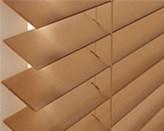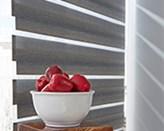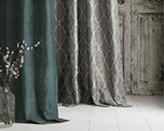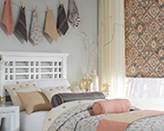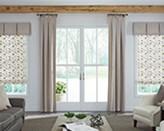Design Considerations
Eco-Friendly & Energy Efficiency
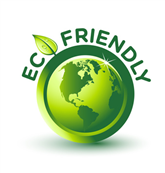 Lafayette Interior Fashions offers materials and fabrics that resist moisture, control light, glare and help manage energy use. Maintaining a safe and sustainable environment is a primary consideration for all of us. Many fabrics are certified for their energy efficiency, air quality safety and use of recycled materials. We strive to include the best “green” advancements into the all Lafayette programs as they become available.
Lafayette Interior Fashions offers materials and fabrics that resist moisture, control light, glare and help manage energy use. Maintaining a safe and sustainable environment is a primary consideration for all of us. Many fabrics are certified for their energy efficiency, air quality safety and use of recycled materials. We strive to include the best “green” advancements into the all Lafayette programs as they become available.
Screen shades are an excellent choice for offices and commercial buildings because they improve comfort and reduce energy costs. Until now, owners and managers had to choose between the superior heat reflective and energy efficiency properties of light color fabrics or the exceptional view-through and glare reduction of dark color fabrics. Now Mermet’s E Screen with KOOLBLACK Technology incorporates superior reflective properties into dark screen fabrics. This breakthrough fabric offers many benefits: lower cooling costs, more comfortable work environments, superior view through and glare control combined with better aesthetics.
The following are Eco terms explained:
GreenAssured®
GreenAssured is ITA's proprietary certification program for envrionmentally compatible window fashion products with their brand. The program is supported by independent labratory testing, using internationally recognized, officially sanctioned protocols. To become certified products must meet strict environmental criteria including airborne chemical emissions and the ecological impacts of the sourcing of raw materials, especially wood. ITA, Inc. developed and implemented the GreenAssured program in response to growing international awareness and concern about the effects of household products on indoor air quality, and the impact on local ecological systems of harvesting endangered or threatened species of trees for wood-based products.
 Both hard and soft window covering materials are tested for emissions of airborne chemicals cited by the U.S. Environmental Protection Agency (EPA) as dangerous to health and safety under the Superfund Amendments and Reauthorization Act, Section 313 (SARA 313), as well as particulates, other potentially harmful substances, and recyclability. To achieve certification, products must comply with emissions limitations and other standards such as: Total aldehydes, including formaldehyde; Volatile organic compounds (VOCs); Respirable particulates; Heat induced off-gas emissions.
Both hard and soft window covering materials are tested for emissions of airborne chemicals cited by the U.S. Environmental Protection Agency (EPA) as dangerous to health and safety under the Superfund Amendments and Reauthorization Act, Section 313 (SARA 313), as well as particulates, other potentially harmful substances, and recyclability. To achieve certification, products must comply with emissions limitations and other standards such as: Total aldehydes, including formaldehyde; Volatile organic compounds (VOCs); Respirable particulates; Heat induced off-gas emissions.
Oeko-Tex™ 100, Confidence in Textiles
The Oeko-Tex Standard 100 provides the textile and clothing industry with a globally uniform standard for the objective assessment of harmful substances. Raw materials, intermediate and end products at all stages of processing throughout the manufacturing chain, including accessories, are tested and certified. Certification is obtained by application in writing from the manufacturer to one of the authorized test institutes or official offices around the globe. The samples submitted are tested exclusively in the member institutes in Europe and Japan in order to ensure a consistently high level of testing. The mark "Confidence in Textiles - Test for harmful substances according to Oako-Text Standard 100" states that the marked product fulfills the conditions specified in this standard, are under the supervision of an institute belonging to the International Association for Research and Testing in the field of Textile Ecology (Oeko-Tex).
 The mark is not a quality label. The mark relates only to the as-produced state of the textile and says noghting about other properties of the product such as e.g. fitness for use, reaction to cleaning processes, physiological behaviour in respect to clothing, properties relating to use in buildings, burning behaviour etc. This mark does not declare anything about harmful substances affecting single specimens of the marked textile as a result of damage during transportation or storing (and improper cleaning procedures thereafter), contamination caused by manipulation for sales promotion (e.g. perfuming) and inadequate sales display.
The mark is not a quality label. The mark relates only to the as-produced state of the textile and says noghting about other properties of the product such as e.g. fitness for use, reaction to cleaning processes, physiological behaviour in respect to clothing, properties relating to use in buildings, burning behaviour etc. This mark does not declare anything about harmful substances affecting single specimens of the marked textile as a result of damage during transportation or storing (and improper cleaning procedures thereafter), contamination caused by manipulation for sales promotion (e.g. perfuming) and inadequate sales display.
Organic Cotton
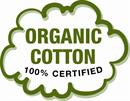 Organic cotton is sustainable, renewable, and biodegradable, making it an excellent choice as an environmentally friendly fiber throughout its product cycle. For a fiber to be considered organic, it must be raised and harvested in accordance with the strict standards of one or more of the many certification companies within the United States and or abroad.
Organic cotton is sustainable, renewable, and biodegradable, making it an excellent choice as an environmentally friendly fiber throughout its product cycle. For a fiber to be considered organic, it must be raised and harvested in accordance with the strict standards of one or more of the many certification companies within the United States and or abroad.
Recycled Materials
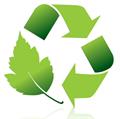 Rather than tossing away post consumer waster (water bottles) and pre consumer waster (damaged products or over runs from manufacturing), recycling these materials is an excellent example of sustainability. Re-using these materials decreases the need to produce new raw materials thus keeping them out of landfills and and helps to sustain our natural resources.
Rather than tossing away post consumer waster (water bottles) and pre consumer waster (damaged products or over runs from manufacturing), recycling these materials is an excellent example of sustainability. Re-using these materials decreases the need to produce new raw materials thus keeping them out of landfills and and helps to sustain our natural resources.

